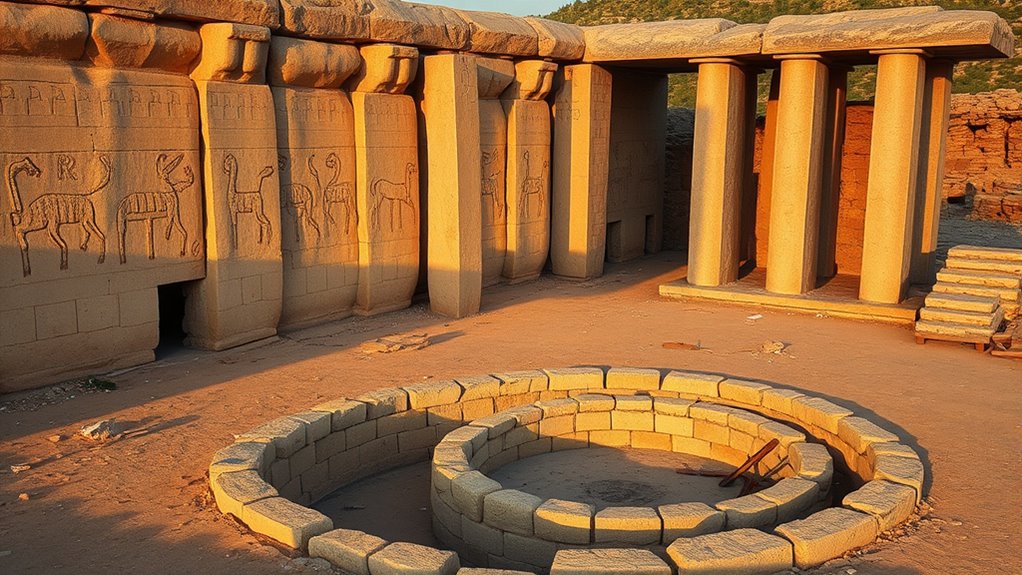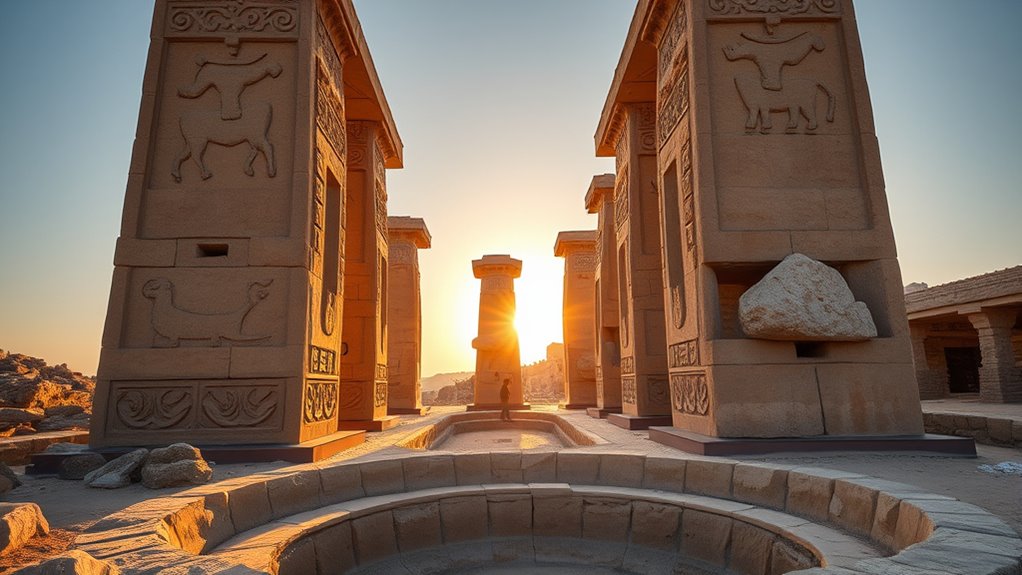Stone-age humans at Göbekli Tepe used careful planning, simple tools, and collective effort to build its impressive stone circles. They transported heavy stones from distant quarries using sledges, rollers, and plenty of manpower. Skilled craftsmanship carved animal motifs and symbols with precision, revealing their spiritual intent. Their social organization allowed coordinated teamwork for construction and ritual activities. Keep exploring to uncover how their advanced skills created this extraordinary site and what it meant for their culture.
Key Takeaways
- They used simple tools like stone pickaxes and wooden levers for shaping and erecting massive stones.
- Stones were transported over long distances using sledges, rollers, and coordinated manpower.
- Construction involved organized labor and social cooperation driven by shared spiritual or ceremonial goals.
- Pillars and stones were carefully carved with symbols and animal motifs, indicating skilled craftsmanship.
- The site’s layout and symbolism suggest advanced planning and collective effort for ritual purposes.

Who exactly built Göbekli Tepe remains one of archaeology’s most intriguing mysteries. You might wonder how stone-age humans, with limited tools and technology, managed to create such an extraordinary site. When you look at the intricately carved pillars and the massive stone circles, it’s clear that this ancient construction wasn’t just about shelter or daily survival. Instead, it served a deeper purpose—one rooted in ritual significance. These structures weren’t random; they were carefully designed for ceremonial or spiritual gatherings, indicating a sophisticated understanding of space and symbolism long before the advent of settled agriculture.
The mysterious builders of Göbekli Tepe crafted ritual sites long before agriculture.
The builders of Göbekli Tepe were likely organized in a way that defies typical assumptions about early human societies. You need to imagine a community coming together, driven by shared beliefs or spiritual needs, to undertake what would have been a monumental effort. They used what resources they had—pickaxes, stone tools, and perhaps wooden levers—to shape and erect these massive pillars. The process of ancient construction here was painstaking and deliberate. Each stone was carefully carved with animal motifs and symbols that held ritual importance, revealing a culture deeply connected to their spiritual worldview. The effort involved not just physical labor but also complex planning, coordination, and a shared vision.
It’s fascinating to consider how they transported these heavy stones from distant quarries, perhaps miles away. You might think they relied on simple sledges or rollers, using manpower to move the stones inch by inch. Once in place, these pillars were arranged in circular formations, perhaps symbolizing celestial bodies or sacred sites. The scale of the work suggests that the builders possessed an impressive understanding of organization and collective effort. They didn’t just build shelters; they created a space imbued with spiritual meaning, indicating that ritual significance was central to their purpose. These structures likely served as communal centers for ceremonies that reinforced social bonds and shared beliefs.
In essence, the construction of Göbekli Tepe was an extraordinary achievement for its time. It required ingenuity, cooperation, and a profound sense of purpose. You can see it as a tribute to early humans’ capacity for complex social organization and spiritual expression. Despite the lack of written records, the craftsmanship and layout reveal that these ancient builders prioritized ritual and symbolism, shaping a site that has puzzled and inspired archaeologists for decades. Their work shows that even in the Stone Age, humans were capable of creating lasting monuments that transcended mere survival—monuments that spoke to their deepest beliefs and communal identity. Interestingly, the site also demonstrates how early humans used symbolic representation to communicate complex ideas and reinforce social cohesion.
Frequently Asked Questions
What Tools Did Göbekli Tepe Builders Use?
You might wonder what tools were used at Göbekli Tepe. The builders relied on stone tools, such as flint and chert blades, to carve and shape the massive limestone pillars. They also used simple quarrying techniques like pounding and chipping to extract stones from quarries. These methods show how skilled they were with basic tools, allowing them to create this impressive site with limited technology.
How Long Did Construction at Göbekli Tepe Take?
They say “Rome wasn’t built in a day,” and that’s true for Stone Age architecture at Göbekli Tepe. Construction likely took several decades, as ancient construction techniques required patience and skill. Stone Age humans worked tirelessly, shaping and placing massive stones without modern tools. The effort reflects their dedication and ingenuity, showing that even in primitive times, perseverance built lasting monuments. Your understanding deepens when you realize such feats took time and effort.
Were There Any Specialized Workers Among the Builders?
You might wonder if there were specialized workers among the builders. Evidence suggests craft specialization existed, with some individuals likely focusing on carving, stone shaping, or monument construction. This implies a social hierarchy, where certain people held specific skills and roles. Such organization would have helped coordinate large-scale efforts, making the complex site possible. So, yes, the builders probably included specialized workers contributing their unique expertise to the project.
How Did They Transport Massive Stone Pillars?
You might wonder how ancient humans transported massive stone pillars. They likely used primitive transportation methods like rolling stones on logs, dragging with ropes, or sledges. Prehistoric engineering techniques, such as leveraging leverage and creating inclined planes, helped move and position the pillars. These methods showcase their ingenuity, allowing them to manipulate large stones despite limited technology, demonstrating impressive early engineering skills.
What Was the Purpose of Göbekli Tepe’S Carvings?
You notice the symbolic carvings on Göbekli Tepe’s pillars, which likely held ritual significance. These intricate designs probably served as spiritual symbols or storytelling tools for the community, emphasizing their beliefs and social cohesion. The carvings’ purpose was to enhance rituals, connect them with their gods, or mark sacred spaces. They reveal how early humans used symbolic art to express their spiritual ideas and reinforce cultural traditions.
Conclusion
Just like skilled artisans shaping a timeless sculpture, you see how Göbekli Tepe’s builders carved history from raw stone. Their work is a shining lighthouse guiding us through the fog of ancient mystery, reminding us that even in the Stone Age, humans possessed the spark of ingenuity and purpose. As you walk away, carry this story like a treasure chest, filled with the awe of what you can achieve when you craft with passion and vision.









